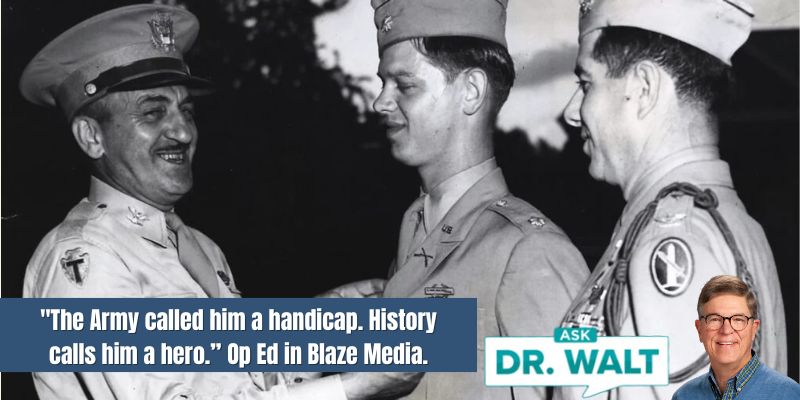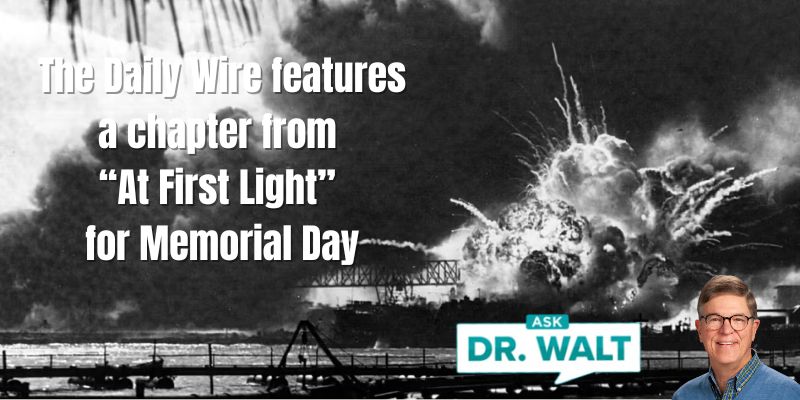
“Ask Dr. Walt” in Today’s Christian Living “Heart-Healthy Humor” (Part 3)
August 21, 2024
August 22, 1944 – Phil’s first letter home from southern France and instructions for V-MAIL
August 22, 2024At four A.M. on Monday, August 21, 1944, an envoy appeared at the Task Force Butler command post at Aspres with a message from General Truscott: “You will move at first light 21 August with all possible speed to Montélimar. Block all routes of withdrawal up the Rhône valley.”[1]

Military Intelligence and air reconnaissance had shown four retreating German divisions concentrated along the Rhône, with a rear guard provided by the 11th Panzer Division.
The U.S. 3rd Division, Truscott’s former command, would act as a hammer in striking from the south, while Task Force Butler and the 36th Division provided the anvil across the Rhône gorge at Montélimar, a town long celebrated for its nouat.
At daybreak, Butler and his wayworn column made a sharp turn to the west and began a sixty-mile dash toward the river.[1]
~~~~~
Our platoons … all moved to an olive grove. Because we were no longer in a fighting area, we did not dig in but slept on top of the ground. The C rations had really gotten old, so when the opportunity presented itself, we all took tomatoes and watermelons from the fields. The battalion headquarters even went so far as to fill a spring wagon full of watermelons that were not quite ripe.
The colonel heard about our escapades and really raised hell about it. First, since the locals fertilized their gardens with remains left in the outhouses, he was concerned that if the vegetables were not thoroughly cleaned, he might have some real sick soldiers. Second, he instructed everyone to make sure they saw the farmer first before taking any produce; he didn’t want any hard feelings from the locals.
Darch brought some tomatoes and onions back, and when I asked him if he had seen the farmer first, he said, “Yes, I saw him way on the other side of the farm!” You could tell the guys really didn’t care about the colonel’s order. … The French people traded us bread and tomatoes for the candy we had, and boy, did it taste good.
We stayed in a home for a night, and while here, almost everybody took this opportunity to wash his clothes. I washed my shirt in a ditch and took a bath in the creek in back of the house where we were staying. People were going by on the road all the time, but no one cared. It had been a while since we’d had the chance to clean up.
Before heading out, we picked up a French boy who had lost both of his parents. He stayed with us until we hit the next town where he was unfortunately hit and killed by a sniper.[2]
~~~~~
Montelimar, where the men were now dashing to capture, was itself is on a small, flat plain extending along the north bank of the Roubion River, a little over two miles east of the Rhone.
Route N-7, the main north-south artery along the Rhone, passes through the city and then runs almost due north to the Drome. A secondary road, D-6, runs northeast from Montelimar about two miles to the small village of Sauzet and then turns east, skirting the northern bank of the Roubion.
On Route N-7, about six miles above Montelimar, is the small town of La Coucourde. Between Montelimar and La Coucourde the eastern side of the Rhone valley narrows considerably, squeezing both N-7 and a parallel railway line between the Rhone and a high ridgeline, which the American troops labeled Hill 300.
The ridgeline easily dominated Route N-7, as well as a parallel road on the west bank of the Rhone and the railways on both sides. Two other hills to the east, Hill 294 and Hill 430, provided additional observation of both banks of the Rhone and, to the south, overlooked the approaches to Sauzet and D-6.
In all, this high ground dominated the Rhone valley for a distance of roughly fifteen miles. All retreating German forces would have to pass through the bottleneck that Task Force Butler was about to squeeze.[3]
~~~~~
By now supply shortages threatened to undermine Truscott’s mast plan.
Thousands of tons of ammunition had been loaded on top of other cargo in ships on the presumption that it would be required for fighting through the beachhead.
Now, stevedores stacked mountains of ammunition above the water line so they could burrow deeper into the holds for desperately needed gasoline and food.
The audacious sprint north—some scouts were almost to Grenoble—required supply trucks to make a three-hundred mile round-trip, but the Seventh Army motor pool on August 21 comprise just sixty-two vehicles.
Three U.S. infantry divisions together were burning 100,000 gallons of gasoline every day, but beach depots on this Monday held only 11,000 gallons.
In the haste to turn ships around, thousands of artillery rounds had been inadvertently send back to the United States, and a thousand mortar shells somehow ended up in Sardinia.
Artillery firing at night was reduced to conserve ammunition, and GIs in the battle zone were placed on two-thirds rations.[4]
~~~~~
By August 21st, the direction of enemy movement had been completely reversed, with convoys nose-to-tail on the northbound route up the valley at Avignon. The Germans were apparently experiencing a critical shortage of fuel; Allied pilots reported sighting many troops being towed on bicycles, with several machines spaced at intervals along a tow rope attached to a troop carrier.[5]
~~~~~
[1]Atkinson, The Guns at Last Light, 207.
[2] Hartstern, 38-39.
[4] Atkinson, Ibid.
[5] Turner, 59.
In case you haven’t read or listened to Dad’s book, you can learn more or order it here.
© Copyright WLL, INC. 2024.




